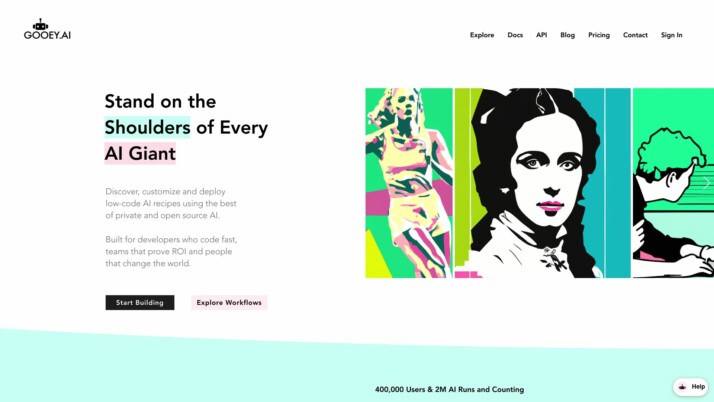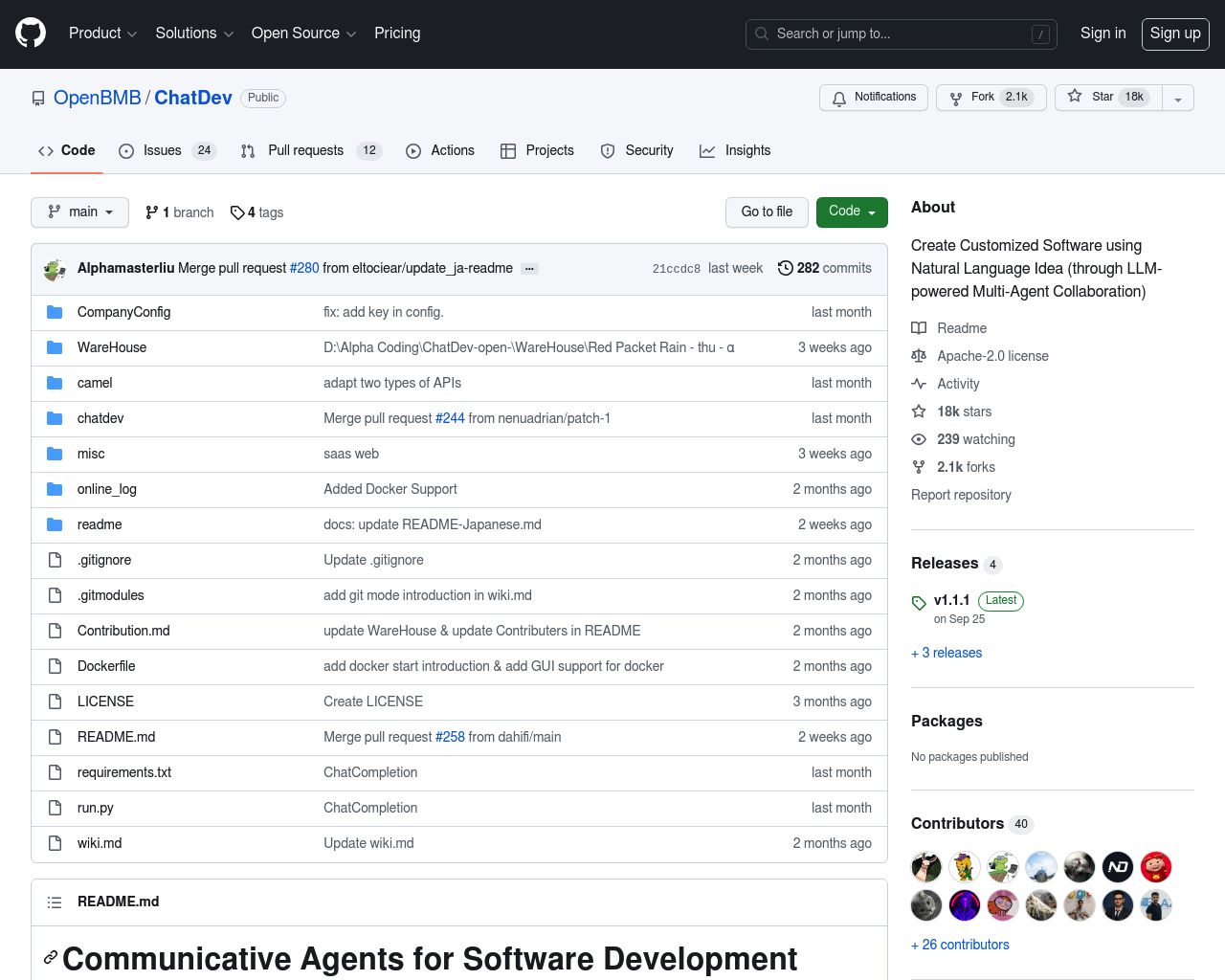Gooey AI vs. ChatDev: Comparing AI Development Platforms
AI development platforms have revolutionized application creation, empowering users to harness advanced technologies without extensive coding knowledge. This comparison explores Gooey AI vs. ChatDev, and SmythOS, three innovative solutions reshaping the AI landscape. Gooey AI specializes in building sophisticated AI Copilots using multiple language models, while ChatDev simulates a virtual software company for automated development. SmythOS emerges as a versatile contender, combining the strengths of both platforms with enhanced features. This analysis delves into each platform’s core capabilities, highlighting their unique approaches to AI-driven development and helping readers determine the best fit for their specific needs.
Gooey AI Overview
Gooey AI empowers users to create sophisticated AI solutions without extensive coding knowledge. The platform specializes in building AI Copilots, leveraging multiple large language models like OpenAI’s GPT-3.5 and GPT-4, and Google’s PaLM2. Gooey AI stands out by integrating both proprietary and open-source AI models, enabling highly customized AI applications.


Screenshot of Gooey AI Website
Gooey AI empowers users to create sophisticated AI solutions without extensive coding knowledge.
The platform’s no-code interface simplifies the development of advanced chatbots and AI agents. Users can harness features such as document OCR, vision capabilities, and integrations with popular platforms like Facebook, Slack, WhatsApp, and Instagram. Gooey AI’s Retrieval Augmented Generation (RAG) ensures AI models provide accurate, up-to-date information by searching through indexed domain-specific documents.
Gooey AI excels in data processing and transformation. The platform can convert videos and PDFs into editable Google Sheets, generate FAQs, and enhance data with citations. These capabilities significantly improve search results and information retrieval. Additionally, Gooey AI offers advanced speech recognition and translation features, powered by models from Azure, Google, Meta, and OpenAI, enabling multilingual support and audio interactions.
For businesses and developers seeking to optimize AI performance, Gooey AI provides tools for bulk testing AI Copilots. This feature allows users to automate evaluations and fine-tune settings, ensuring high-quality and reliable outputs. The platform’s focus on creating measurable value through AI workflows and chatbots aligns with its vision of enhancing productivity, unlocking knowledge, and helping users accomplish tasks through conversational interfaces.
Gooey AI provides tools for bulk testing AI Copilots… allowing users to automate evaluations and fine-tune settings, ensuring high-quality and reliable outputs.
While Gooey AI offers a robust set of features, users should consider potential limitations. The platform’s reliance on third-party AI models may impact customization options for highly specialized use cases. Additionally, as with many AI platforms, users must carefully manage data privacy and security, especially when handling sensitive information across various integrations.
ChatDev Overview
ChatDev revolutionizes software development by simulating a virtual software company using large language models (LLMs). This open-source framework automates the entire development process, from design to deployment, through a team of AI agents collaborating on various roles.


ChatDev’s AI agents, including virtual CEOs, CTOs, programmers, and testers, communicate through a structured chat chain to break down complex tasks. This innovative approach enables rapid software creation, with the ability to develop simple applications in minutes for a fraction of traditional costs.
ChatDev revolutionizes software development by simulating a virtual software company using large language models (LLMs). This open-source framework automates the entire development process…
The platform stands out with its transparency, allowing users to replay entire development conversations in a web app. It leverages Camel-AI for agent communication and incorporates thought instructions and self-reflection mechanisms to minimize errors and enhance code quality. ChatDev also integrates with Git for version control, facilitating collaborative development practices.
While ChatDev excels in automating software development, it faces challenges in scalability and customization for complex enterprise needs. The platform’s reliance on predefined agent roles may limit flexibility in highly specialized development scenarios. Additionally, the quality of output heavily depends on the underlying LLMs, which may require frequent updates to maintain cutting-edge performance.
ChatDev’s vision to democratize software development through AI automation positions it as a valuable tool for developers and companies seeking to streamline their processes. However, users should consider their specific project requirements and the platform’s limitations when evaluating its suitability for large-scale or highly customized development tasks.
Feature Comparison
Gooey AI and ChatDev offer distinct approaches to AI-powered software development, each with its own strengths and limitations. Gooey AI excels in creating sophisticated AI Copilots using multiple large language models, while ChatDev simulates an entire virtual software company using AI agents.
Gooey AI provides a robust no-code interface for building AI solutions, making it accessible to users without extensive programming knowledge. Its platform supports multimodal capabilities, including text, audio, and video inputs. In contrast, ChatDev focuses on automating the entire software development process through AI agents that collaborate in predefined roles such as CEO, CTO, and programmer.
A significant gap exists in core components between the two platforms. Gooey AI offers advanced features like Retrieval Augmented Generation (RAG) and synthetic data extraction, enhancing the accuracy and relevance of AI responses. ChatDev, however, lacks these specific capabilities, instead emphasizing its unique approach to simulating a software development team.
In terms of security, Gooey AI likely includes standard practices like data encryption, though it’s not explicitly mentioned. ChatDev’s documentation doesn’t highlight specific security features, which could be a concern for users handling sensitive information. This gap in security documentation and features may give Gooey AI an edge for users prioritizing data protection.
While both platforms aim to streamline AI-driven development, their approaches and target use cases differ significantly. Gooey AI’s focus on building versatile AI Copilots makes it suitable for a wide range of applications, from chatbots to data processing. ChatDev’s specialized approach to software development simulation may limit its applicability outside of coding-specific tasks.
We offer a comprehensive suite of features that address the limitations of both Gooey AI and ChatDev. Our platform combines the accessibility of no-code interfaces with advanced security measures, multimodal capabilities, and flexible deployment options. Unlike ChatDev’s narrow focus on software development simulation, our solution provides a versatile framework for creating AI agents across various industries and use cases.
Feature Comparison Table
| Gooey AI | ChatDev | SmythOS | |
|---|---|---|---|
| CORE FEATURES | |||
| Visual Builder | ✅ | ❌ | ✅ |
| No-Code Options | ✅ | ❌ | ✅ |
| Bulk Work | ✅ | ❌ | ✅ |
| Agent Work Scheduler | ✅ | ❌ | ✅ |
| SECURITY | |||
| Constrained Alignment | ✅ | ❌ | ✅ |
| IP Control | ❌ | ❌ | ✅ |
| COMPONENTS | |||
| Zapier APIs | ❌ | ✅ | ✅ |
| Data Lakes | ❌ | ❌ | ✅ |
| DEPLOYMENT OPTIONS (EMBODIMENTS) | |||
| Staging Domains | ❌ | ❌ | ✅ |
| Production Domains | ❌ | ❌ | ✅ |
| Deploy as Scheduled Agent | ✅ | ❌ | ✅ |
| Scalability | ✅ | ❌ | ✅ |
| DATA LAKE SUPPORT | |||
| Hosted Vector Database | ✅ | ❌ | ✅ |
| Sitemap Crawler | ❌ | ❌ | ✅ |
| YouTube Transcript Crawler | ✅ | ❌ | ✅ |
| TXT File Support | ✅ | ❌ | ✅ |
Best Alternative to Gooey AI and ChatDev
SmythOS stands out as the superior alternative to Gooey AI and ChatDev, offering a comprehensive platform for AI agent development and deployment. We combine the best aspects of both competitors while addressing their limitations, providing a versatile solution for businesses and developers alike.
Our drag-and-drop interface surpasses Gooey AI’s no-code options, making AI development accessible to users of all skill levels. Unlike ChatDev’s narrow focus on software development simulation, SmythOS enables the creation of AI agents for diverse applications across industries. This flexibility allows users to tackle a wide range of challenges, from customer service to data analysis.
SmythOS stands out as the superior alternative to Gooey AI and ChatDev, offering a comprehensive platform for AI agent development and deployment.
We prioritize security and scalability, addressing key concerns in AI deployment. Our platform includes robust features like data encryption, OAuth integration, and IP control, ensuring your AI agents operate in a secure environment. These security measures give SmythOS an edge over both Gooey AI and ChatDev, particularly for enterprises handling sensitive information.
SmythOS shines in its deployment options and integration capabilities. We offer multiple deployment methods, including APIs, webhooks, scheduled agents, and site chat integrations. This versatility, combined with our support for various data formats and APIs, enables seamless integration into existing workflows. Whether you’re building a chatbot, automating tasks, or developing complex AI systems, SmythOS provides the tools and flexibility to bring your vision to life.
By choosing SmythOS, you’re not just selecting an AI agent builder; you’re investing in a future-proof platform that evolves with your needs. Our commitment to innovation, user-friendly design, and comprehensive feature set makes us the ideal choice for businesses and developers looking to harness the full potential of AI technology.
Conclusion
Gooey AI and ChatDev offer unique approaches to AI-powered development, but SmythOS emerges as the superior choice for businesses seeking comprehensive AI solutions. While Gooey AI excels in creating AI Copilots and ChatDev simulates software development teams, SmythOS provides a versatile platform that combines the best of both worlds and extends far beyond.
Our drag-and-drop interface surpasses Gooey AI’s no-code tools, enabling users to create sophisticated AI workflows without extensive coding knowledge. Unlike ChatDev’s narrow focus on software development, SmythOS supports a wide range of applications across industries, from chatbots and APIs to scheduled agents and data processing pipelines.
SmythOS stands out with its extensive integration ecosystem, supporting over 300,000 integrations and compatibility with various AI models. This flexibility, combined with our multi-agent orchestration capabilities, empowers users to build complex, scalable AI solutions that outperform both Gooey AI and ChatDev in versatility and functionality.
Experience the future of AI development with SmythOS. Create a free account to explore our platform’s capabilities, or dive into our comprehensive documentation to learn how SmythOS can revolutionize your AI initiatives. Unlock limitless AI integrations and deploy your agents anywhere with SmythOS – the ultimate platform for building and scaling AI solutions.
Last updated:
Disclaimer: The information presented in this article is for general informational purposes only and is provided as is. While we strive to keep the content up-to-date and accurate, we make no representations or warranties of any kind, express or implied, about the completeness, accuracy, reliability, suitability, or availability of the information contained in this article.
Any reliance you place on such information is strictly at your own risk. We reserve the right to make additions, deletions, or modifications to the contents of this article at any time without prior notice.
In no event will we be liable for any loss or damage including without limitation, indirect or consequential loss or damage, or any loss or damage whatsoever arising from loss of data, profits, or any other loss not specified herein arising out of, or in connection with, the use of this article.
Despite our best efforts, this article may contain oversights, errors, or omissions. If you notice any inaccuracies or have concerns about the content, please report them through our content feedback form. Your input helps us maintain the quality and reliability of our information.
